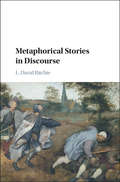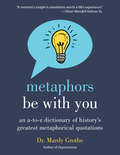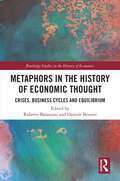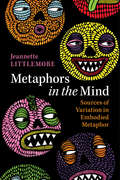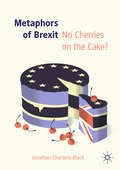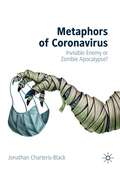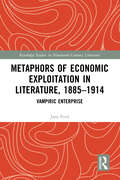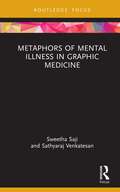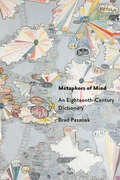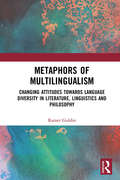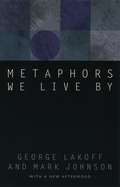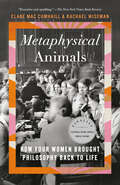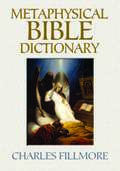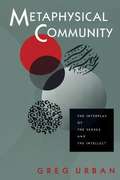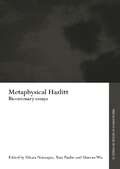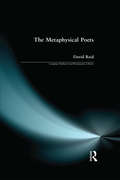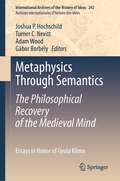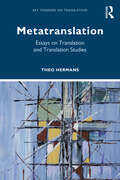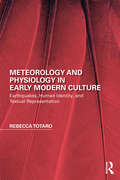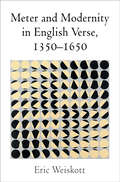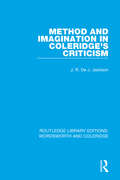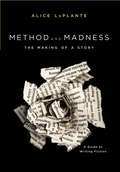- Table View
- List View
Metaphorical Stories in Discourse
by Ritchie L. DavidWhen Hillary Clinton conceded in 2008 that she didn't quite 'shatter the glass ceiling', and when Rick Perry in 2012 called Mitt Romney a 'vulture capitalist', they used abbreviated metaphorical stories, in which stories about one topic are presented as stories about something entirely different. This book examines a wide range of metaphorical stories, beginning with literary genres such as allegories and fables, then focusing on metaphorical stories in ordinary conversations, political speeches, editorial cartoons, and other communication. Sometimes metaphorical stories are developed in rich detail; in other examples, like 'vulture capitalist', they may merely be referenced or implied. This book argues that close attention to metaphorical stories and story metaphors enriches our understanding and is essential to any theory of communication. The book introduces a theoretical structure, which is developed into a theory of metaphorical stories and then illustrates the theory by applying it to actual discourse.
Metaphors Be With You: An A to Z Dictionary of History's Greatest Metaphorical Quotations
by Dr Mardy GrotheRespected quotation anthologist and author of Oxymoronica and Viva la Repartee Dr. Mardy Grothe is at his best in Metaphors Be with You, an A to Z dictionary of 2,750 of history's greatest metaphorical quotations, meticulously curated for writers, readers, and quotation lovers everywhere.In Metaphors Be with You, Dr. Mardy Grothe has created the definitive reference on English's finest metaphors, sourced from literature, politics, philosophy, Hollywood, religion, sports, comedy, history, religion, pop culture, and more. Arranged into two sections--"The Ten Best Things Ever Said" and "The Single Best Thing Ever Said"--Metaphors Be with You includes quotations on five hundred human interest topics and an introduction to the nature, importance, and sheer joy of metaphorical language.Essential for writers, readers, and language aficionados, this breathtaking, beautifully designed sourcebook also contains elegantly integrated digital access to Dr. Mardy's Dictionary of Metaphorical Quotations, the world's largest online database of quotations containing metaphors, similes, and analogies. This one-of-a-kind synergy between print and technology offers a comprehensive look at the diversity of words and phrases we use to relate to, understand, and describe our world by providing access to detailed source information, innumerable "Error Alerts," and fascinating quotation backstories that will engage readers as they delve into metaphorical language and discover their own favorites.Whether you're crafting a speech, writing a novel, or simply searching for new ways to express yourself, this remarkable compendium is sure to inspire you with the perfect metaphor every time.
Metaphors in International Relations Theory
by Michael P. MarksMetaphors constitute a fundamental way in which humans understand the world around them. This book offers a comprehensive analysis of metaphors in theories of international relations. Until recently, conscious attention to metaphors in theories of international relations has been haphazard and sporadic. This book examines the metaphors that inform the major paradigms in international relations theory. Readers will discover that the vast majority of the terminology cataloguing, defining, and naming theories, concepts, and analytical tools pertaining to the study of international relations are metaphorical in nature. The book concludes that metaphors are an essential element in all aspects of international relations theory.
Metaphors in the History of Economic Thought: Crises, Business Cycles and Equilibrium (Routledge Studies in the History of Economics)
by Roberto Baranzini Daniele BesomiMetaphors in the History of Economic Thought: Crises, Business Cycles and Equilibrium explores the evolution of economic theorizing through the lens of metaphors. The edited volume sheds light on metaphors which have been used by a range of key thinkers and schools of thought to describe economic crises, business cycles and economic equilibrium. Structured in three parts, the book examines an array of metaphors ranging from mechanics, waves, storms, medicine and beyond. The international panel of contributors focuses primarily on economic literature up to the Second World War, knowing again that the use of metaphors in economic work has seen a resurgence since the 1980s. This work will be of interest to advanced students and researchers in the history of economic thought, and economics and language.
Metaphors in the Mind: Sources of Variation in Embodied Metaphor
by Jeannette LittlemoreAbstract concepts are often embodied through metaphor. For example, we talk about moving through time in metaphorical terms, as if we were moving through space, allowing us to 'look back' on past events. Much of the work on embodied metaphor to date has assumed a single set of universal, shared bodily experiences that motivate our understanding of abstract concepts. This book explores sources of variation in people's experiences of embodied metaphor, including, for example, the shape and size of one's body, one's age, gender, state of mind, physical or linguistic impairments, personality, ideology, political stance, religious beliefs, and linguistic background. It focuses on the ways in which people's experiences of metaphor fluctuate over time within a single communicative event or across a lifetime. Combining theoretical argument with findings from new studies, Littlemore analyses sources of variation in embodied metaphor and provides a deeper understanding of the nature of embodied metaphor itself.
Metaphors of Brexit: No Cherries on the Cake?
by Jonathan Charteris-BlackHow were social media posts, scripted speeches, traditional news media and political cartoons used and understood during the Brexit campaign? What phrases and metaphors were key during and after the 2016 Brexit referendum? How far did the Remain and Leave campaigns rely on metaphor to engage with supporters in communicating their political positions? These questions, and many others, can be answered only through a systematic analysis of the actual language used in relation to Brexit by the different parties involved. By drawing on a range of data sources and types of communication, and presenting them as 'frames' through which individuals can attempt to understand the world, the author provides the first book-length examination of the metaphors of Brexit. This book takes a detailed look at the rhetorical language behind one of the major political events of the era, and it will be of interest to students and scholars of linguistics and political science, as well as anyone with a special interest in metaphor, rhetoric, Brexit, or political communication more broadly.
Metaphors of Coronavirus: Invisible Enemy or Zombie Apocalypse?
by Jonathan Charteris-BlackThis book explores the metaphors used in public and media communication to ask how language shapes our moral reasoning about the global coronavirus crisis. The author offers insights into the metaphors, metonyms, allegories and symbols of the global crisis and examines how they have contributed to policy formation and communication. Combining metaphor theory with moral foundations theory, he places metaphors in their historical contexts, and then critically questions why certain tropes might be used in particular situations to persuade and convince an audience. The book takes an integrated approach, involving ideas from cognitive linguistics, history, social psychology and literature to produce a multi-layered and thematically rich interpretation of the language of the pandemic and its social and political consequences. It will be relevant to readers with a background in these areas, as well as anyone with a general interest in the language used to make sense of this global event.
Metaphors of Economic Exploitation in Literature, 1885-1914: Vampiric Enterprise (Routledge Studies in Nineteenth Century Literature)
by Jane FordMetaphors of Economic Exploitation in Literature, 1885–1914 explores the complex network of metaphors that emerged around late nineteenth-century conceptions of economic self-interest – metaphors that dramatised the predatory, conflictual, and exploitative basis of relations between nations, institutions, sexes, and people in a fin-de-siècle economy that was perceived by many as outwardly belligerent. More specifically, this book is about the vampire, cannibal, and related genera of economic metaphor that penetrate the major discourses of the period in ways that have yet to be understood. In chapters that examine socialist fiction and newspapers; the imperial quest romance; the decadent and supernatural tales of Henry James and Vernon Lee; and the Catholic novels of Lucas Malet, Ford assesses the breadth and variety of these metaphors, and considers how they filter the long-standing philosophical ideas about self-interest and the conflictual ‘economic man’. This volume is essential reading for students and scholars of fin-de-siècle literature and culture as well as those with an interest in the relationship between literature, economics, and anti-capitalist movements.
Metaphors of Mental Illness in Graphic Medicine (Routledge Focus on Literature)
by Sathyaraj Venkatesan Sweetha SajiThis book investigates how graphic medicine enables sufferers of mental illness to visualise the intricacies of their internal mindscape through visual metaphors and reclaim their voice amidst stereotyped and prejudiced assumptions of mental illness as a disease of deviance and violence. In this context, by using Lakoff and Johnson’s conceptual metaphor theory (CMT), this study uncovers the broad spectrum of the mentally ills’ experiences, a relatively undertheorised area in medical humanities. The aim is to demonstrate that mentally ill people are often represented as either grotesquely exaggerated or overly romanticised across diverse media and biomedical discourses. Further, they have been disparaged as emotionally drained and unreasonable individuals, incapable of active social engagements and against the healthy/sane society. The study also aims to unsettle the sanity/insanity binary and its related patterns of fixed categories of normal/abnormal, which depersonalise the mentally ill by critically analysing seven graphic narratives on mental illness.
Metaphors of Mind: An Eighteenth-Century Dictionary
by Brad PasanekA pathbreaking introduction to eighteenth-century metaphors of the mind that recasts the grand narrative of the Enlightenment in terms of its tropes and figures.An encyclopedic dictionary along the lines of Voltaire’s classic Dictionnaire Philosophique, Metaphors of Mind provides an in-depth look at the myriad ways in which Enlightenment writers used figures of speech to characterize the mind. Drawn from Brad Pasanek’s massive online archive, http://metaphorized.net, this volume constitutes a veritable treasury of mental metaphorics.Dividing the book into eleven broad metaphorical categories—Animals, Coinage, Court, Empire, Fetters, Impressions, Inhabitants, Metal, Mirror, Rooms, and Writing—Pasanek maps out constellations of metaphors. He frames his collection of literary excerpts in each section with a more descriptive and theoretical discussion of what he calls "desultory reading," a form of unsystematic perusal of writing frequently employed by Enlightenment thinkers. By surveying the printed past alongside the digital present, the book treats eighteenth-century writing as its topic while essentially exemplifying its rhetorical approach.More than an exercise in quotation, this intellectual history offers illuminating readings of fragmentary literary works and confrontations with neoclassical and contemporary theories of metaphor. The book’s entries complicate received ideas about Locke’s blank slate, question M. H. Abrams’ claims about mirrors and lamps, and chart changing frequencies of metal metaphors in a moment of industrial revolution. The book also responds to current anxieties about reading and the mass digitization of literature, touching on recent discussions of "distant reading," "shallow reading," and "surface reading." Promoting critical and creative anachronism, Metaphors of Mind redefines the notion of an archive in the age of Amazon and Google Books.
Metaphors of Multilingualism: Changing Attitudes towards Language Diversity in Literature, Linguistics and Philosophy
by Rainer GuldinMetaphors of Multilingualism explores changing attitudes towards multilingualism by focusing on shifts both in the choice and in the use of metaphors. Rainer Guldin uses linguistics, philosophy, literature, literary theory and related disciplines to trace the radical redefinition of multilingualism that has taken place over the last decades. This overall change constitutes a paradigmatic shift. However, despite the emergence of the new paradigm, the traditional monolingual point of view is still significantly influencing present-day attitudes towards multilingualism. Consequently, the emergent paradigm has to be studied in close connection with its predecessor. This book is the first extensive attempt to provide a critical overview of the key metaphors that organize current perceptions of multilingualism. Instead of an exhaustive list of possible metaphors of multilingualism, the emphasis is on three closely interrelated and overlapping clusters that play a central role in both paradigms: organic metaphors of the body, kinship and gender metaphors, as well as spatial metaphors. The examples are taken from different languages, among them French, German, Chinese, Japanese, Spanish and Brazilian Portuguese. This is ground-breaking reading for scholars and researchers in the fields of linguistics, literature, philosophy, media studies, anthropology, history and cultural studies.
Metaphors We Live By
by George Lakoff Mark JohnsonThe now-classic Metaphors We Live By changed our understanding of metaphor and its role in language and the mind. Metaphor, the authors explain, is a fundamental mechanism of mind, one that allows us to use what we know about our physical and social experience to provide understanding of countless other subjects. Because such metaphors structure our most basic understandings of our experience, they are "metaphors we live by"—metaphors that can shape our perceptions and actions without our ever noticing them. In this updated edition of Lakoff and Johnson's influential book, the authors supply an afterword surveying how their theory of metaphor has developed within the cognitive sciences to become central to the contemporary understanding of how we think and how we express our thoughts in language.
Metaphors We Live By
by George Lakoff Mark JohnsonThe now-classic Metaphors We Live By changed our understanding of metaphor and its role in language and the mind. Metaphor, the authors explain, is a fundamental mechanism of mind, one that allows us to use what we know about our physical and social experience to provide understanding of countless other subjects. Because such metaphors structure our most basic understandings of our experience, they are "metaphors we live by"--metaphors that can shape our perceptions and actions without our ever noticing them. In this updated edition of Lakoff and Johnson's influential book, the authors supply an afterword surveying how their theory of metaphor has developed within the cognitive sciences to become central to the contemporary understanding of how we think and how we express our thoughts in language.
Metaphysical Animals: How Four Women Brought Philosophy Back to Life
by Clare Mac Cumhaill Rachael WisemanA NEW YORK TIMES BOOK REVIEW BEST BOOK OF THE YEAR • A vibrant portrait of four college friends—Iris Murdoch, Philippa Foot, Elizabeth Anscombe, and Mary Midgley—who formed a new philosophical tradition while Oxford's men were away fighting World War II.The history of European philosophy is usually constructed from the work of men. In Metaphysical Animals, a pioneering group biography, Clare Mac Cumhaill and Rachael Wiseman offer a compelling alternative. In the mid-twentieth century Elizabeth Anscombe, Mary Midgley, Philippa Foot, and Iris Murdoch were philosophy students at Oxford when most male undergraduates and many tutors were conscripted away to fight in the Second World War. Together, these young women, all friends, developed a philosophy that could respond to the war&’s darkest revelations.Neither the great Enlightenment thinkers of the past, the logical innovators of the early twentieth century, or the new Existentialist philosophy trickling across the Channel, could make sense of this new human reality of limitless depravity and destructive power, the women felt. Their answer was to bring philosophy back to life. We are metaphysical animals, they realized, creatures that can question their very being. Who am I? What is freedom? What is human goodness? The answers we give, they believed, shape what we will become.Written with expertise and flair, Metaphysical Animals is a lively portrait of women who shared ideas, but also apartments, clothes and even lovers. Mac Cumhaill and Wiseman show how from the disorder and despair of the war, four brilliant friends created a way of ethical thinking that is there for us today.
Metaphysical Bible Dictionary (Dover Empower Your Life Ser.)
by Charles FillmoreA notable product of the 19th-century New Thought revolution, Charles Fillmore's Unity movement combined esoteric and metaphysical principles with traditional Christian elements. This key to Fillmore's original form of religious expression, a core text of the Unity movement, interprets the hidden meanings of the Bible's myriad names, places, and events.
Metaphysical Community: The Interplay of the Senses and the Intellect
by Greg UrbanStarting with the post-structuralist idea that truth systems are lodged in discourse, and that discourse varies from society to society, Greg Urban seeks to discover the nature and extent of that variation. <P><P>His journey to an Amerindian society in which dreams are more prominent than everyday aspects of the sensible world leads him to radically reformulate one of the main problematics of Western thought: the relationship between our sensations of the world and the understandings we form of them. <P> Metaphysical Community proposes that this dichotomy comes from the interplay between two sides of discourse-its intelligible side as a carrier of meanings, and its sensible side as thing-in-the-world that must be replicated. This insight leads to the heart of the book-the exploration of the uneasy tension that binds experience and understanding, phenomena and noumena.
Metaphysical Hazlitt: Bicentenary Essays (Routledge Studies in Romanticism #Vol. 5)
by Duncan Wu Tom Paulin Uttara NatarajanThe rediscovery and restitution of William Hazlitt as a canonical Romantic author has been among the latest and most significant developments in present-day Romantic studies. This volume, a collection of previously unpublished essays by the foremost scholars in the field presents Hazlitt as a philosophical, and not simply a 'familiar' essayist. It offers a comprehensive statement of the significance and transmission of Hazlitt's philosophical principles, in his own work and in that of his contemporaries and succeeding writers. This book is an essential contribution to a vital new aspect of Romantic studies and shows Hazlitt to be, as his memorial claims, 'The first (unanswered) Metaphysician of the age'.
The Metaphysical Poets (Longman Medieval and Renaissance Library)
by David ReidThe Metaphysical Poets provides an introduction to the work of six strikingly various and original poets- Donne, Herbert, Crashaw, Vaughan, Marvell and Traherne. By closely examining how the poems work, the book aims to help readers at all stages of proficiency and knowledge to enjoy and critically appreciate the ways in which fantastic and elaborate styles may express private intensities. The emphasis is on the differences covered by the term 'Metaphysical' and on the rich and strange diversity of the poets' inner lives. The book examines the expressive forms of interiority, the characteristic inward turn of Metaphysical wit, and compares the wit of its six poets with the non-introspective wit of poets such as Cowley, the Cavaliers and the Augustans. The discussion of each poet is preceded by a 'Life' in which the biographical facts, personal, cultural and political, are treated with a view to illuminating the concerns of the poems.
Metaphysics Through Semantics: Essays in Honor of Gyula Klima (International Archives of the History of Ideas Archives internationales d'histoire des idées #242)
by Joshua P. Hochschild Turner C. Nevitt Adam Wood Gábor Borbély“More than any other living scholar of medieval philosophy, Gyula Klima has influenced the way we read and understand philosophical texts by showing how the questions they ask can be placed in a modern context without loss or distortion. The key to his approach is a respect for medieval authors coupled with a commitment to regarding their texts as a genuine source of insight on questions in metaphysics, theology, psychology, logic, and the philosophy of language—as opposed to assimilating what they say to modern doctrines, or using medieval discussions as a foil for ‘new and improved’ conceptual schemes.” Jack Zupko, University of Alberta“Gyula Klima is widely recognized as one of the world’s leading experts on thirteenth and fourteenth-century Latin philosophy, with his own, distinctive analytic approach, which brings out both the similarities and differences between medieval and contemporary logic and semantics.” John Marenbon, Trinity College, University of Cambridge “Gyula Klima has been a towering figure in the field of medieval philosophy for decades. His influence comprises not only the scholarly results of his work, but also intense and generous mentorship of students and junior colleagues. This volume is a perfect reflection of the esteem that he enjoys around the world, collecting excellent pieces by established as well as up-and-coming scholars of medieval philosophy.” Catarina Dutilh Novaes, Vrije Universiteit Amsterdam“For four decades now, Gyula Klima has been setting the standard among medievalists for philosophical sophistication and historical rigor. This collection of wide-ranging studies from leading scholars in the field offers a worthy tribute to that legacy.” Robert Pasnau, University of Colorado BoulderGyula Klima is Professor of Philosophy at Fordham University, and Senior Research Fellow, Consultant, and the Director of Institute for the History of Ideas of the Hungarian Research Institute in Budapest. In 2022, the President of Hungary awarded him the Knight’s Cross of the Hungarian Order of Merit, “in recognition of his outstanding academic career, significant research work and exemplary leadership.” In this volume, colleagues, collaborators, and students celebrate Klima’s project with new essays on Plotinus, Anselm, Aquinas, Buridan, Ockham and others, exploring specific questions in philosophy of mind, philosophy of language, metaphysics, and logic.No contemporary surpasses Kripke and Klima in semantics and metaphysics, but only Gyula Klima’s thought ranges flawlessly over classical philosophy as well. The volume is a fitting tribute to the master. David Twetten, Marquette University
Metapoesis: The Russian Tradition from Pushkin to Chekhov
by Michael C. FinkeReaders have been schooled to see nineteenth-century Russian literature as the summit of social and psychological realism. But in the work of writers from Pushkin to Chekhov, Michael C. Finke discloses a pervasive self-referentiality, a running commentary on the literary conventions these texts seem so wholly to embody. Metapoesis examines how--and more importantly, why--a series of major Russian authors spanning the nineteenth century inscribed commentary on their own poetics into their works of drama, narrative poetry, and fiction. As he explores the process of metapoesis in these works, Finke reveals its communicative function in its time and its interpretive value in our own.Jakobsonian poetics provides the framework for this approach, though Finke also draws freely upon a number of contemporary literary theorists. After elucidating the meaning of metapoesis in works by Pushkin, Gogol, and Chernyshevsky, he reveals its covert functioning in such masterpieces of realism as Dostoevsky's The Idiot, Tolstoy's Anna Karenina, and Chekhov's "The Steppe." The result is a new interpretation and deeper understanding of these particular works, which in turn reorient our understanding of linguistic and literary "codes" and of the Russian literary tradition itself.Of special interest to scholars of Russian literature, Metapoesis will also appeal to a broad range of readers and students of comparative literature, literary theory, and poetics.
Metatranslation: Essays on Translation and Translation Studies (Key Thinkers on Translation)
by Theo HermansMetatranslation presents a selection of 14 key essays by leading theorist, Theo Hermans, covering a span of almost 40 years. The essays trace Hermans’ work and demonstrate how translation studies has evolved from the 1980s into the much more diverse and self-reflexive discipline it is today. The book is divided into three main sections: the first section explores the status and central concerns of translation studies, including the growing interest in sociological, ideological and ethical approaches to translation; the second section investigates the key concepts of translation norms and of the translator’s presence, or positioning, in translated texts; the historical essays in the final section are concerned with both modern and early modern discourses on translation and with the use of translation as an instrument of war and propaganda. This synthesis of the work of a highly influential pioneer in translation studies is essential reading for researchers, scholars and advanced students of translation studies, intercultural studies and comparative literature.
Meteorology and Physiology in Early Modern Culture: Earthquakes, Human Identity, and Textual Representation (Perspectives On The Non-human In Literature And Culture Ser.)
by Rebecca TotaroMeteorology and Physiology in Early Modern Culture: Earthquakes, Human Identity, and Textual Representation provides the first sustained examination of the foundational set of early modern beliefs linking meteorology and physiology. This was a relationship so intimate and, to us, poetic that we have spent centuries assuming early moderns were using figurative language when they represented the matter and motions of their bodies in meteorological terms and weather events in physiological ones. Early moderns believed they inhabited a geocentric universe in which the matter and motions constituting all sublunary things were the same and that therefore all things were compositionally and interactively related. What physically generated anger, erotic desire, and plague also generated thunder, the earthquake, and the comet. As a result, the interpretation of meteorological events, such as the 1580 earthquake in the Dover Strait, was consequential. With its radical and seemingly spontaneous shaking, an earthquake could expose inconvenient truths about the cause of matter and motion and about what, if anything, distinguishes humans from every other thing and from events. Meteorology and Physiology in Early Modern Culture reveals a need for reexamination of all representations of meteorology and physiology in the period. This reexamination begins here with a focus on the Titanic metamorphoses captured by Edmund Spenser, William Shakespeare, John Donne, and the many writers responding to the 1580 earthquake.
Meter and Modernity in English Verse, 1350-1650
by Eric WeiskottWhat would English literary history look like if the unit of measure were not the political reign but the poetic tradition? The earliest poems in English were written in alliterative verse, the meter of Beowulf. Alliterative meter preceded tetrameter, which first appeared in the twelfth century, and tetrameter in turn preceded pentameter, the five-stress line that would become the dominant English verse form of modernity, though it was invented by Chaucer in the 1380s. While this chronology is accurate, Eric Weiskott argues, the traditional periodization of literature in modern scholarship distorts the meaning of meters as they appeared to early poets and readers.In Meter and Modernity in English Verse, 1350-1650, Weiskott examines the uses and misuses of these three meters as markers of literary time, "medieval" or "modern," though all three were in concurrent use both before and after 1500. In each section of the book, he considers two of the traditions through the prism of a third element: alliterative meter and tetrameter in poems of political prophecy; alliterative meter and pentameter in William Langland's Piers Plowman and early blank verse; and tetrameter and pentameter in Chaucer, his predecessors, and his followers. Reversing the historical perspective in which scholars conventionally view these authors, Weiskott reveals Langland to be metrically precocious and Chaucer metrically nostalgic.More than a history of prosody, Weiskott's book challenges the divide between medieval and modern literature. Rejecting the premise that modernity occurred as a specifiable event, he uses metrical history to renegotiate the trajectories of English literary history and advances a narrative of sociocultural change that runs parallel to metrical change, exploring the relationship between literary practice, social placement, and historical time.
Method and Imagination in Coleridge's Criticism (RLE: Wordsworth and Coleridge #6)
by J.R. de J. JacksonFirst published in 1969, this book places Coleridge’s literary criticism against the background of his philosophical thinking, examining his theories about criticism and the nature of poetry. Particular attention is paid to the structure of Biographia Literaria, Coleridge’s distinction between Imagination and Fancy, his definitions of the poetic characters of Shakespeare and Wordsworth, his analysis of the mental state of audiences in theatres, and his interpretations of Paradise Lost, Hamlet and Aeschylus’ Prometheus. The emphasis throughout is on how Coleridge thought rather than what he thought and the process rather than the conclusions of his criticism.
Method and Madness: The Making of a Story: A Guide to Writing Fiction
by Alice LaplanteMethod and Madness takes its title from Hamlet: “Though this be madness, yet there is method in't.” Comprehensive and accessible, it provides guidelines to all aspects of fiction writing, from generating ideas to getting published. With a wealth of imaginative yet practical exercises and 39 stories—the most in any guide to fiction writing—Method and Madness offers friendly, down-to-earth instruction in the art and craft of fiction.
